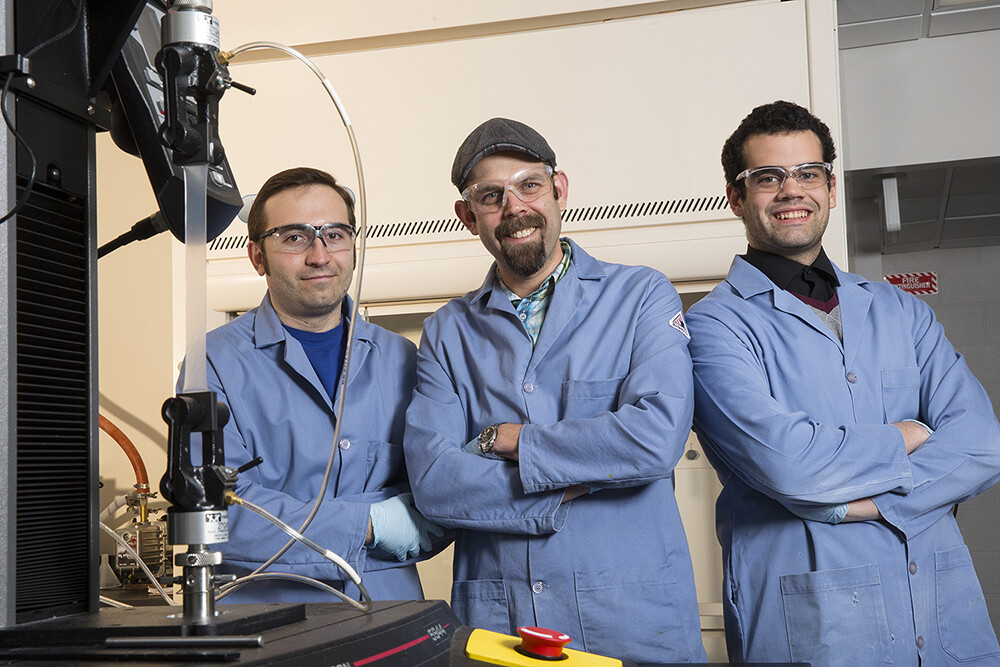
Researchers at the University of Nebraska-Lincoln have shown that instantly transforming a dull surface to a mirror-like sheen is hardly a stretch. In fact, that’s all it takes.
UNL chemist Stephen Morin and his colleagues have developed a method for crafting elastic materials that feature a matte appearance when relaxed but become highly reflective when stretched.
Beyond an array of decorative possibilities offered by the materials, the team has envisioned uses that could keep consumers from overstressing elastic products and inform the design of soft displays that resemble conventional screen technologies.
The team’s technique involves bathing stretched rubber material in solutions of inorganic salts that eventually crystallize as rigid films on the soft surface. Those films acquire microscopic wrinkles when the rubber material is relaxed, similar to the way a Band-Aid does when applied over a bent elbow that is then straightened.
In its relaxed form, the wrinkle-covered surface scatters light and appears relatively dull. But stretching the material flattens out the wrinkles, yielding a reflective sheen that varies based on the wide range of chemicals that can be used to synthesize the film.
The researchers found that a material coated with cadmium sulfide film went from completely non-reflective to about 30 percent reflective when stretched, while the reflectance of a gold-covered surface increased by roughly 70 percent.
“To our knowledge, no one has shown this type of adaptive reflectance behavior using elastic materials coated with inorganic films,” said Morin, an assistant professor of chemistry who co-authored a new study detailing the fabrication technique. “And switching between reflectance states doesn’t work just once or twice; we were able to show that this would work a thousand times, stretching and relaxing, over and over again.”
The study reported that the elastic materials actually progress through three stages of reflectance: non-reflective when relaxed, reflective when moderately stretched, then back to non-reflective when severely stressed.
“The functionality of optical devices is usually set in stone at the time of manufacturing,” said co-author Christos Argyropoulos, assistant professor of electrical and computer engineering. “Dynamic and reconfigurable optical devices based on the demonstrated mechanism would be extremely useful.”
Among the most straightforward applications proposed by Morin: acting as a passive sensor that indicates the strain being put on a material. The reflectance thresholds might be used to indicate when a cargo-securing strap has reached its tearing point, for instance, or help visually gauge the proper inflation level of a tire’s inner tube.
Further work could lead to more sophisticated applications. The study demonstrated how pneumatics could be used to expand millimeter-sized sections of a coated surface, increasing its light reflectance in the process. By reducing the scale of the pneumatics and tailoring the surface chemistry of the film, engineers could potentially produce visual displays on soft materials by stressing tiny sections of the surface to simulate the appearance of digital pixels.
Morin said such technology is gaining interest among designers of soft robotics, which eschew the rigid metallic skeletons of conventional robotics in favor of more pliable designs that can operate in ways their counterparts cannot.
“One of the things that people are looking for in that field is how they can augment the functionality of the basic structural materials they use, which are rubbers, with some other type of properties so that they can access new applications,” said Morin. “Soft robotics, soft machines, soft displays, soft sensors: These areas are really attracting a lot of interest and are growing rapidly. People are realizing, ‘If I make a soft robot, then I need soft sensors and soft display elements to make this come together.’ That relies on combining materials with different types of functionality into hybrid structures.”
Morin said the elastic materials could further prove useful in research involving Raman spectroscopy, a technique that helps identify the presence, bonds and configurations of even single molecules residing on a surface.
The team’s successful marriage of soft, elastic materials with hard, brittle films might also allow for the investigation of biological processes that feature similar interfaces.
“In biomineralization, which is the process where bone and teeth are created, you’re always dealing with the soft-hard interface,” Morin said. “You have cells and proteins … that are mitigating the deposition and growth of very different materials (such as) calcium carbonate.
“If one were interested in systematically studying those interfaces, especially during nucleation and growth, this wouldn’t be a bad system to start with.”
The team’s study, which appeared in the journal Advanced Materials, features research funded in part by the National Science Foundation. Morin and Argyropoulos co-authored the paper with Jay Taylor, graduate student in chemistry.








